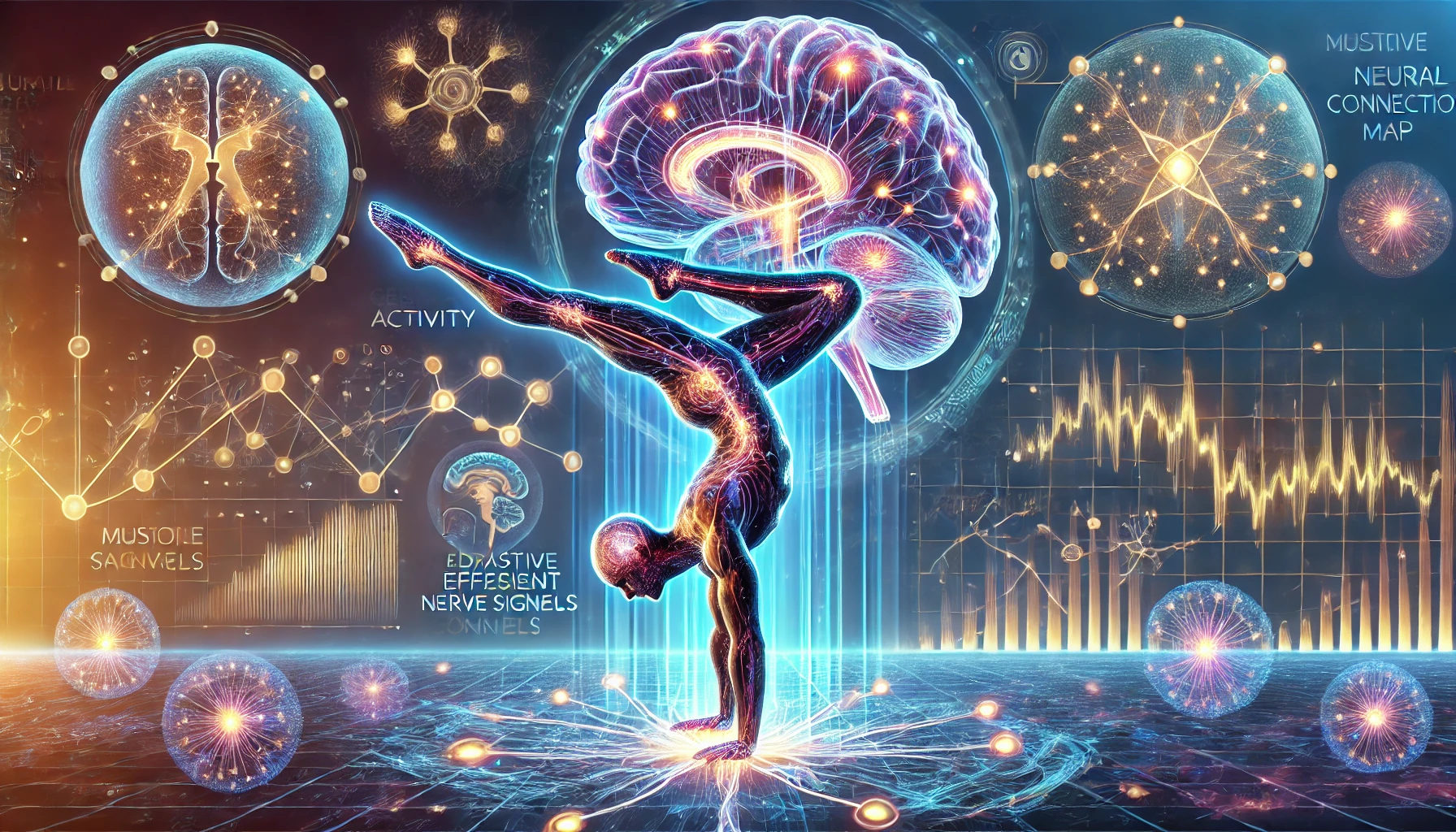The Fascinating Science Behind Handstand
Did you know that learning a handstand literally rewires your brain? The moment you flip upside down, your nervous system goes into overdrive, firing up new neural connections at lightning speed.
Your brain isn’t just keeping you upright—it’s adapting, balancing, and recalibrating in real-time, transforming you into a literal human gyroscope.
But how does your brain actually map itself to master the perfect handstand?
“The body achieves what the mind believes.” – Napoleon Hill
The Science of Brain Mapping – What’s Actually Happening?
The brain is a fascinating organ—it challenges you first, then rewards you for pushing forward. Every time you attempt a handstand, your nervous system gathers data, adjusts, and refines its movement patterns.
To truly understand how brain mapping works, let’s break it down into three key sections:
1. Your Brain Creates a ‘Body Map’ in the Motor Cortex
Your brain has a map of your entire body, called the somatosensory cortex (responsible for touch and movement). It knows exactly where your arms, legs, and torso are in space.
This is why you can walk without looking at your feet—your brain already knows where they are.
💡 The Problem?
Your brain’s default body map is built for standing upright.
But when you flip upside down, this map becomes useless.
🔥 Your brain still expects your feet to balance you.
🔥 Your hands aren’t mapped as “balancers” yet.
This is why at first, handstands feel impossible. Your nervous system has to redraw the entire body map.
2. Neuroplasticity: Your Brain Rewires Itself.
🧠 Neuroplasticity = The brain’s ability to rewire itself.
The more you train handstands:
✅ Your brain adapts to the new balance system.
✅ Your proprioception (body awareness) shifts to your hands.
✅ Your vestibular system (inner ear balance) adjusts to upside-down gravity.
💡 The crazy part?
This rewiring doesn’t happen in one moment—it happens gradually, through repetitions.
That’s why handstands feel impossible at first—but after weeks of training, your brain suddenly “gets it.”
3. The Fight or Flight Mode of the Nervous System
🔥 Your nervous system treats handstands like a ‘new language.’
Ever noticed that at first, you panic upside down, but later, you feel calm?
That’s because your autonomic nervous system is adapting.
Your nervous system has two modes:
🟢 Parasympathetic (Calm, Relaxed State)
🔴 Sympathetic (Fight or Flight Mode)
💡 What happens in early handstand training?
- Your brain detects instability → It activates fight-or-flight mode → You panic and fall.
- With practice → Your brain realizes you are safe → It relaxes the reflex → You balance longer.
🚀 The more you train, the more your nervous system shifts handstands into “normal” mode.
How Your Nervous System Adapts to Being Upside Down
Now that we know the science of what and how everything works, let’s go one layer deeper and understand how our nervous system adapts to being upside down in three phases:
Phase 1: Sensory Overload (First time trying a handstand)
The brain freaks out: “WHERE IS UP? WHERE IS DOWN? WHAT ARE MY HANDS EVEN DOING?”
Your vestibular system (inner ear) is your body’s balance command center.
It works by detecting:
✅ Head position relative to gravity
✅ Acceleration and movement
💡 The Problem?
Your vestibular system is trained for upright walking (like we discussed earlier).
The moment you flip upside down, it loses its reference points.
Handstand training forces your brain to recalibrate what “balance” means. Over time, your inner ear gets better at processing upside-down movement.
That’s why:
✅ Beginners feel dizzy when first training handstands.
✅ With practice, the dizziness disappears.
✅ Advanced hand-balancers feel comfortable in any position.
🚀 Your brain literally redefines balance itself.
Note from PAST JOY: So just like I’m writing right now or learning something new, I feel overwhelmed… And that overwhelm is so great that I stop doing that thing. But now, as I am learning more, I am realizing that it’s just a phase I need to overcome—like climbing a mountain to see that serene view. Without doing the hard work and facing the overwhelm, I could never feel that “FEELING” or overcome my fear.
The real progress begins when I overcome Phase 1. As they say, “Enjoy the journey,” and that journey’s path starts with Phase 1.
Phase 2: Neural Calibration (Your body starts mapping balance)
At this stage, your brain and nervous system are shifting gears, transitioning from confusion to controlled adaptation. Your muscles might still feel shaky, but beneath the surface, powerful recalibrations are happening.
- Your brain starts building ‘upside-down’ muscle memory.
- The cerebellum (balance control center) gets to work, helping you adjust micro-movements.
- The spinal cord refines reflexes, so you react faster to weight shifts.
💡 Fun Fact: Gymnasts’ brains are wired differently. Studies show that professional gymnasts have larger cerebellums (the part of the brain responsible for balance) than the average person!
Phase 3: Myelination & Superhuman Reflexes (Mastering control)
Every time you practice a handstand, your brain coats your neurons with myelin.
🔥 More myelin = Faster, smoother, and stronger neural connections.
🚨 Why Some People Learn Handstands Faster:
- They train daily. (More myelin coating = stronger neural circuits.)
- They use slow, controlled repetitions. (Better muscle memory.)
- They embrace falling & mistakes. (More error correction leads to better learning.)
Myelination is why handstand pros barely think when balancing—it’s automatic, like riding a bike! 🚴♂️
🔥 How to Maximize Myelin Growth:
1️⃣ Train consistently, even if it’s just 5 minutes daily.
2️⃣ Perform quality reps over quantity. (Bad form = bad myelin wiring.)
3️⃣ Use visualization before practicing. (Step one for hacking your nervous system for faster learning.)
💡 Mind-Blowing Insight: Learning a handstand literally reshapes your brain. Studies on athletes and gymnasts show increased gray matter density in regions responsible for balance and movement.
Note from PAST JOY: Yaarr, our brain is soooo fascinating… OH MY GOD!
The Brain-Body Connection: How to Hack Your Nervous System for Faster Learning
1. Build a ‘Handstand Mental Map’ Before You Even Go Upside Down
- Visualize yourself balancing in a handstand.
- Close your eyes and imagine shifting weight between your fingers.
💡 Game-changer: Visualizing handstands activates the same brain regions as actually doing them! Mental practice speeds up neuromuscular adaptation.
2. Activate the Vestibular System (Balance Like an Acrobat)
Have you ever wondered how cats, monkeys, and lizards balance effortlessly without overthinking?
Unlike humans, whose balance develops over years, many animals master it within weeks. The secret lies in their hyper-adaptive vestibular system and an exceptionally tuned cerebellum.
Meanwhile, humans must consciously rewire their nervous system to achieve the same level of control. A great way to start? Head tilts and rolling drills to strengthen your inner ear’s adaptability.
3. Use Slow, Controlled Negatives (Slow Motion = Faster Brain Adaptation)
Instead of kicking up wildly, practice slow descents to teach your nervous system balance mechanics.
Bruce Lee trained in slow-motion combat, forcing his nervous system to develop extreme precision, balance, and reaction speed.
4. Train Handstand ‘Micro-Adjustments’ (Finger Control = Stability)
- Grip the floor like a rock climber—your fingers are your stabilizers.
- Use wall drills to practice subtle weight shifts.
💡 Cool Trivia: Astronauts go through a similar adaptation period when experiencing microgravity—their brains have to remap balance just like when learning a handstand.
Falling is Actually a FEATURE, Not a Failure in Brain Mapping
Most people fear falling (including me) when attempting a handstand, but failure isn’t the opposite of progress—it’s the mechanism that drives it. Every fall is a real-time lesson for your nervous system, forcing your brain to refine coordination, timing, and muscle control.
“Knowing what not to do is always more important than knowing what to do.”
This is one of the biggest mistakes we make when learning handstands (more on this in the next section).
Here’s How Failure Actively Improves Your Balance:
- Your brain learns through error correction: Every time you fall, your cerebellum logs the mistake, adjusts its motor output, and refines movement patterns for the next attempt. Over time, this ‘error correction’ system makes you more stable.
- Repetition builds neural pathways: Just like a child learning to walk, repeated attempts strengthen the neural circuits required for handstand control. The more you fall and retry, the faster your brain develops predictive balance—meaning you adjust before falling rather than after.
- Elite athletes leverage ‘failure loops’ to master skills: Gymnasts and acrobats train on foam pits or padded mats because they understand that controlled failure is the fastest path to improvement. By eliminating the fear of injury, they push their limits, allowing their bodies to adapt more quickly.
- Fear of falling stiffens your body: When you’re afraid of failing, your body instinctively tenses up, making balance harder. Learning to embrace falls with relaxed confidence lets your body respond dynamically, increasing control.
So, instead of resisting failure, embrace it as part of the learning process. The best hand-balancers weren’t born with perfect coordination—they just fell, adapted, and kept going until their brains and bodies worked in sync.
Why Most People Fail at Handstands (And How to Avoid It)
🚫 Mistake #1: Relying on Strength Instead of Balance
✅ Solution: Train alignment, core control, and neural adaptation, not just brute strength.
🚫 Mistake #2: Not Letting the Brain Adapt Gradually
✅ Solution: Start with short holds, progress slowly, and give your nervous system time to adjust.
🚫 Mistake #3: Panicking When Upside Down
✅ Solution: Learn to stay calm in an inverted position before focusing on full balance.
Note from Past Joy: My brute strength is developed… I need to FOCUS on core control and glute activation and especially work on the “Falling Mechanics.” So right now, I am making 2 out of 3 biggest mistakes. (And I am super happy because they are the low-hanging fruits.)
Common Reflexes That Sabotage Your Handstand:
| Reflex | Effect | How to Override |
|---|---|---|
| Righting Reflex | Tries to keep head upright | Train slow, controlled inversions |
| Fear Reflex | Triggers flinching/falling | Progressive exposure to inversion |
| Stretch Reflex | Causes stiffness in wrists | Wrist mobility drills |
| Startle Reflex | Overactivates fight-or-flight | Deep breathing & relaxation techniques |
💡 AHA Moment: The fear of falling is not just psychological—it’s a hardwired survival response. But the more you practice, the more your brain stops treating handstands as a “threat.”
Advanced Neuroscience Hacks to Improve Handstand Learning
I won’t go too much into detail about these three for now, but in the future, I’ll definitely make posts diving deeper into each. For now, here’s a quick breakdown of how they work:
🧠 The ‘Mirror Neuron’ Effect:
Watching elite hand balancers in slow motion primes your nervous system to replicate their movements. Your brain starts mapping the motion patterns, making it easier to execute them yourself. Dr. Dan Siegel – Explains Mirror Neurons in Depth
🔥 ‘Forced Adaptation’ Drills:
Deliberately challenging your balance (using unstable surfaces, closing your eyes, or varying hand positions) forces your nervous system to adapt more efficiently, improving overall control. That’s how Samurais used to train!
🎯 Use External Feedback Loops:
Recording your handstands and watching them frame-by-frame helps identify subtle imbalances and refine technique faster.
Note from Past Joy: I’ve started my Handstand Journal to track and record my progress daily, starting from DAY 01. I know how powerful journaling and feedback loops are for accelerating learning.
The ‘1% Rule’ – How to Improve Handstand Balance Faster Than 99% of People
📊 The 1% Compound Effect: Small Gains, Massive Results
“We are what we repeatedly do. Excellence, then, is not an act, but a habit.” – Aristotle
If you improve your handstand by just 1% daily, the compounding effect will make you unstoppable.
How the 1% Rule Works
Imagine you start by holding a handstand for 5 seconds. If you improve by just 1% daily, that means:
- Day 1: 5.05 seconds
- Day 30: 6.75 seconds
- Day 90: 15+ seconds
- Day 180: 40+ seconds
- Day 300+: 1+ minute hold
At first, these gains seem tiny—barely noticeable. But tiny improvements stack up exponentially, and in a few months, you’ll be balancing longer than 99% of people who quit after a few failed attempts.
How to Apply the 1% Rule for Handstands
1️⃣ Start Small, Stay Consistent
- Set a daily baseline (e.g., 5-second holds, wall drills, or freestanding attempts).
- Aim for 1% more time, control, or stability each day.
2️⃣ Micro-Adjust, Don’t Overhaul
- If you struggle, don’t overhaul your technique—tweak one small thing (hand pressure, shoulder angle, core engagement).
- 1% improvement in technique = long-term mastery.
3️⃣ Track Progress to Reinforce Growth
- Keep a handstand journal or timer to visually see progress.
- Seeing your seconds increase fuels motivation.
4️⃣ Never Miss Twice
- Skipped a day? No problem—just don’t skip twice. Consistency compounds when you show up imperfectly but regularly.
Just stick to the 1% Rule, and before you know it, you’ll be holding your first handstand while others are still struggling with their first 10 seconds.
This is my handstand game plan too!
“A journey of a thousand miles begins with a single step.” – Lao Tzu
Your handstand journey isn’t about massive leaps. It’s about showing up daily, improving by just 1%, and letting time do the rest.
I’ve also discussed the 1% Rule in detail, so be sure to check it out!
Conclusion: The Ultimate Brain Hack?
Handstands = The Ultimate Test of Brain-Body Coordination.
The handstand is one of the most advanced forms of motor learning because it requires:
🔥 Real-time neuroplasticity (rebuilding your brain’s body map)
🔥 Advanced proprioception (sensing balance through your hands instead of feet)
🔥 Vestibular recalibration (teaching your inner ear a new balance system)
🔥 Fear response training (teaching your nervous system that upside-down is safe)
💡 This is why handstands feel like a superpower.
Your entire brain is working to adapt, making you:
✅ More coordinated in all movement
✅ More mentally focused
✅ More in control of your body than ever before
So yeah, this is how our nervous system adapts to being upside-down… The number of curiosity loops this has opened in my mind is just insane. I know you’re getting the same feeling. To conclude the whole post in one sentence:
🔥 “Train smart, not just hard. Your brain is the key to unlocking the perfect handstand.”
Read next:
- Superhuman Balance Test – Are You Handstand-Ready?
- The Handstand Hall of Fame – Masters Who Took Handstands to the Next Level



